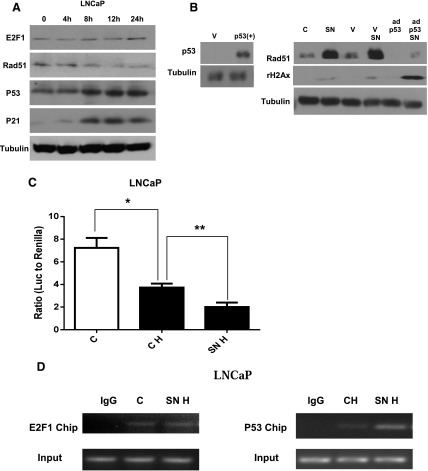Fig. 6.
p53 suppresses Rad51 transcription and sensitizes prostate cancer cells to drug-induced DNA damage. (A) Western blots showing levels of E2F1, Rad51, p53, and p21 at different time points (0, 4, 8, 12, and 24 hours) after SN38 treatment in LNCaP cells under hypoxia. (B) Western blots show the restoration of wild-type p53 in PC3 cells after infection with p53/GFP adenovirus 5 (ad-p53). Levels of rH2Ax and Rad51 in PC3 cells with or without SN38 treatment under hypoxia were compared among cells that were uninfected or infected with GFP adenovirus 5 vector (V) or p53/GFP adenovirus 5 (ad-p53) infected cells. (C) Dual luciferase reporter assays of RAD51 promoter activities in LNCaP with or without 16 hours of SN38 treatment under hypoxia. (D) ChIP assays comparing RAD51 promoter occupancy by E2F1 and p53 with or without SN38 treatment under hypoxia. C, untreated control; CH, control untreated under hypoxia; SN, SN38; SNH, SN38 treated under hypoxia. Tubulin was used as the loading control. Three replicates were performed for each experiment. Each column represents the mean and S.E.M. of three independent experiments. *P < 0.05; **P < 0.01.

